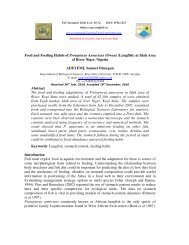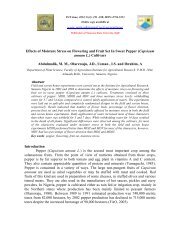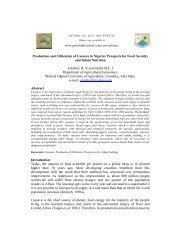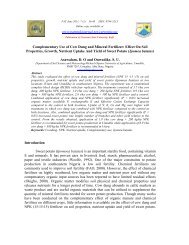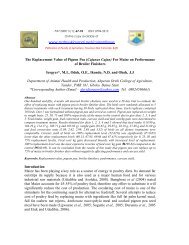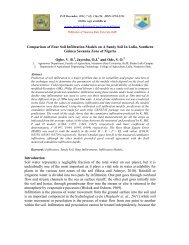View Publication - Production Agriculture and Technology Journal
View Publication - Production Agriculture and Technology Journal
View Publication - Production Agriculture and Technology Journal
- No tags were found...
You also want an ePaper? Increase the reach of your titles
YUMPU automatically turns print PDFs into web optimized ePapers that Google loves.
PAT 2012; 8 (2):11-24: ISSN: 0794-5213; Anikweze G U: The Challenges of Pattern Drafting ….… 12Methods of Pattern DraftingHollen (1972) advocated three methods of pattern making, namely: Flat-Pattern,Draping <strong>and</strong> Drafting.Flat-Pattern drafting, according to Semptress (2010) is the art of taking a set ofmeasurements, a sheet of paper, <strong>and</strong> a pen, <strong>and</strong> coming away with a pattern. Flatpattern is based on commercialized basic patterns with st<strong>and</strong>ard measurements butwhen employed in designing, one makes use of fitting darts to increase garment fitting.Hollen (1972) posited that Flat - Pattern has several advantages which include theability to design patterns to fit into economical fabric layouts, the possibility of restylingold patterns <strong>and</strong> out-of-date clothing into new ones, the ease for determining causes ofmistakes <strong>and</strong> how to correct them, <strong>and</strong> flexible planning for new procedures <strong>and</strong>efficient organization of work.Commercial Patterns are drafted patterns made by professional patterncompanies or industries. They are sold in different sizes; hence Fayemi; George;Akingbemi; Abraham; Akinsete <strong>and</strong> Douglas (1989) advise that individuals shouldknow their body measurements in order to select the correct size. To ensure accuratemeasurements for mens patterns, Musheno (1980) advised that the stance of the manbeing measured should be natural <strong>and</strong> kept away from mirrors which despite theassumption of an ideal figure (one that is too erect, <strong>and</strong> with taut rather than relaxedmuscles) will cause the garment to fit improperly with normal stance. For a female,Thomas (2009) prescribes that the lady should st<strong>and</strong> straight <strong>and</strong> be relaxed in anupright posture with feet together.Taking accurate measurement is regarded as the foundation on which drafting asa method of pattern designing is built (Weber, 1990; Clayton, 1997; Aldrich, 2006;Horton, 2008). As if to justify this point, Ezema (1996) noted that such principles ofdesign as proportion, balance, rhythm, emphasis <strong>and</strong> harmony, all depend on accuratemeasurements. Kindersley (1996) also posited that accurate measurements are neededfor choosing a pattern size. A perfect fit, she argued, is ensured by comparing your ownmeasurements with those of the pattern, taking tolerance into account <strong>and</strong> thereaftermaking any adjustments. Pattern pieces are measured between the seam lines, not fromedge to edge. Similarly, the art elements of design such as vertical lines, horizontallines, diagonal lines, curved lines, <strong>and</strong> shape rely on accurate measurements if they willhave the desired effects in communicating emotions, ideas, feelings <strong>and</strong> mood (Ezema,1996).Both Weber (1990) <strong>and</strong> Clayton (1997) believed that custom fit of garmentsbegins with accurate measurements. This implies that the success of any system of flatpattern drafting will depend upon the accuracy with which the measurements have beentaken <strong>and</strong> the accuracy with which they are translated to the pattern. It is difficult toreplicate body measurements because each person has a different h<strong>and</strong> with the tape
PAT 2012; 8 (2):11-24: ISSN: 0794-5213; Anikweze G U: The Challenges of Pattern Drafting ….… 13measure (Minott, 1978). Consequently, the most common error in measuring ismeasuring too tightly. Saladino (1970) had suggested measuring with one or two fingersunder the tape measure to allow ease while Weber (1990) suggested the assistance ofsomebody to ensure accuracy. The stance of the person being measured may varyduring the measurement session or in the time from measurement to fitting.Draping is an artistic approach in which the person makes a pattern by fitting alarge rectangle of woven cloth around the body so that the folds in the fabric producethe dress pattern according to the curves of the body. Vulker <strong>and</strong> Cooper (1987)suggested that draping originated from the Greeks <strong>and</strong> the Romans. The Greeks calledtheir draped garment a chiton whose shape was achieved by draping, girdles <strong>and</strong>pinning after which embroidery was applied. The Romans had different names fordraped garments for males <strong>and</strong> females. The male garment was called Tunica while thefemale draped dress was called Stola. Vulker <strong>and</strong> Cooper (1987) noted that drapingrequired little technical skill, as no patterns or sewing were required, hence drapedgarments began to be replaced by clothing cut to a pattern. However, anybody whowishes to embark on large scale garment production by draping approach to patternmaking could do so through line-for-line copy of already sewn garment.Drafting is a scientific process of pattern designing that is based on a set of bodymeasurements. Therefore, taking accurate measurements is the foundation of creativityin pattern making. Okorie (2000) regards creativity <strong>and</strong> knowledge of measurements asimperative characteristics of garment designers. Draft patterns usually rely on basicpattern as foundation or master pattern. The basic pattern for mens wear (shirt <strong>and</strong>trouser) consists of several measurements to achieve custom fit (Musheno, 1980). Forshirt patterns, the needed measurements consist of neck, neckb<strong>and</strong>, shoulder, chest,centre front length, centre back, back width, waist, arm length, arm circumference, <strong>and</strong>sleeve length. For trousers, the required measurements are the waist, seat (hip), highhip, thigh, knee, out-seam (side lengths), Inseam, <strong>and</strong> hemline. Aldrich (2006)recommends st<strong>and</strong>ard body measurements for the dresses of men of average built (about5ft 10ins or 178cm). This is shown in table 1 below. Musheno (1980) suggested that theactual measurement of the pattern piece for men will be larger than the bodymeasurement for which it is designed in order to allow wearing ease. Musheno (1980)has provided Vogues average body measurements for women with fully developed figure<strong>and</strong> height of about 5 6 (1.60M). This is shown in Table 2 while Table 3 shows thewomens pattern sizes.
PHYSICAL EXAMINATION(To be filled out by Physician – please note information on reverse side)The purpose of this health record is to provide the staff with pertinent information, which will help to serve the needs ofthis child in Day Camps <strong>and</strong> Afterschool <strong>and</strong> Youth Center Programs.IMMUNIZATION HISTORY – This is a record of dates of basic immunization <strong>and</strong> most recent booster doses.DpaP, DTP or TDPolio\MMR\DateDateDateDateDateDateDateDateDateDateDateDateDateDateDateHemophilus Influenzae type b Date Date Date Date DateHepatitus BVaricellaOtherDateDateDateDateDateDateDateDateDateDateDateDateMEDICAL EXAMINATION – To be filled out by licensed physicianExamination is acceptable when performed no more than 12 months prior to arrival at camp.Code: S = Satisfactory X = No Satisfactory (Explain) 0 = Not ExaminedGeneral AppearanceHeight Weight Blood Pressure Hgb. Test (Date)Urinalysis (Date) Posture & Spine Throat – TonsilsEyes Vision w/Glasses Extremities HeartEars Hearing Feet Lungs SkinNose Teeth Abdomen HerniaGenitaliaNeurological FindingsDescribe Abnormal Findings <strong>and</strong>/or H<strong>and</strong>icapping ConditionsHas child ever received products containing horse serum?Allergy: (Please specify)Recommendations <strong>and</strong> restrictions while in camp.Special DietSpecial Medicine (name it)Is parent/guardian sending special medicine?SwimmingActivity RestrictionsGeneral Appraisal:DivingI have examined the person herein described, reviewed his/her health history <strong>and</strong> it is my opinion that he/she is physically ableto engage in Day Camp/Year Round Afterschool <strong>and</strong> Youth Center activities, except as noted above.EXAMINING PHYSICIAN (SIGNATURE)M.D.TelephoneDate of ExaminationAddressPHYSICIAN’S NAME (PLEASE PRINT)ZIP CODE
PAT 2012; 8 (2):11-24: ISSN: 0794-5213; Anikweze G U: The Challenges of Pattern Drafting ….… 15There are today commercialized basic patterns of st<strong>and</strong>ard sizes but Vulker <strong>and</strong> Cooper(1987:84) insisted that their use must follow certain principles of design, namely: Line<strong>and</strong> Direction, Shape <strong>and</strong> Proportion, Colour, <strong>and</strong> Texture.The line of a dress gives a direction to be followed by eyes. Lines may be vertical,horizontal, oblique or curved. The direction of a line can assist in creating an illusionthat may camouflage a figure problem. For instance, horizontal lines could make awoman appear wider that she really is. This is because the eyes of beholders follow thelines across the person.Shape remains significant in pattern designing because it gives the silhouette oroutline of the clothing, although the shape of garment changes with fashion (Clayton,1987; Rouse, 1989). The outline of the clothing affects its proportions which refer to thespace relationships within the design, <strong>and</strong> involves relating such measurements as size<strong>and</strong> bulk (Musheno, 1980). Good proportion is achieved when the various sections of agarment relate well to the whole garment. Different proportions suit different figures;hence, Horton (2008) advises that the type of figure, its proportions <strong>and</strong>characteristics should be considered when selecting the style of a garment so as todisguise figure problems. Consideration of figure type <strong>and</strong> body measurements is alsonecessary in order to avoid too much of pattern alterations before achieving a perfect fit.She further argued that female body shapes vary greatly, <strong>and</strong> so patterns are sized notonly for direct measurements but for figure types of varying proportions.Colour is linked with aesthetics <strong>and</strong> can affect our emotions <strong>and</strong> moods. Webber (1990)stated that colours act symbols that convey several messages. She illustrated with thecolours of traffic lights without which there would be traffic jam. She noted that whilesome colours suggest coolness, others appear hot. According to her, red, orange, <strong>and</strong>yellow colours express excitement <strong>and</strong> simulate action while blue, green <strong>and</strong> violet havea subduing effect <strong>and</strong> convey a sense of calm <strong>and</strong> relaxation. Even our experienceshows that while bright colours such as red <strong>and</strong> yellow are happy <strong>and</strong> exciting, black<strong>and</strong> grey seem to be somber <strong>and</strong> depressing to some people. Vulker <strong>and</strong> Cooper (1987)posit that dark colours tend to make people look smaller, while brighter colours couldmake people appear bigger. They therefore advise that women with heavy hips shouldchoose cool colours for their skirts.Texture is an important design element. Ezema (1996) noted that texture isassociated with the sense of touch. The texture of a fabric may be rough <strong>and</strong> bulky likewool, shiny like satin or dull <strong>and</strong> soft like velvet. Musheno (1980) stated that texturecontributes to an impression of size. Hence, rough <strong>and</strong> thick textures seem more bulkythan they really are. Similarly, shiny, lustrous fabrics reflect more light <strong>and</strong> thus makeone to appear larger than the person really is.
PAT 2012; 8 (2):11-24: ISSN: 0794-5213; Anikweze G U: The Challenges of Pattern Drafting ….… 16Development of the Pattern Drafting SystemBody shape will be analyzed to determine the measurements necessary to describe bodylength, width, curves, <strong>and</strong> angles. The essential measurements according to Varney(1980) are:Length: Hip depth, Shirt length, Back bodice length, Front bodice length,Apex level, Shoulder length, Arm length, <strong>and</strong> In-seamWidth: Hipline - front <strong>and</strong> back, Upper leg, Neck, Chest line - front <strong>and</strong>back, Arm, <strong>and</strong> WaistlineCurves & Angles: Waist to floor - side, center front, <strong>and</strong> center back,Contour waist to floor - front <strong>and</strong> back, <strong>and</strong> Shoulder slopeVarney (1980) also observed that width measurements varied considerably when takenwith a tape measure. She therefore devised a method of using strips of pattern tissuepaper one cm wide <strong>and</strong> long enough to encircle the part of the body being measured.Because the paper was relatively fragile, it will not depress the flesh without breaking;<strong>and</strong> an accurate measurement could be obtained. Harold & John (1992) <strong>and</strong> Igbo &Iloeje (2003), have suggested different methods of making patterns to obtain well-fittedgarments for women with different figure types. These include flat pattern, draping,knock - off methods, computer aided design (CAD) <strong>and</strong> drafting pattern.Factors to consider in Clothing ConstructionThe critical issue in dress designing is to achieve clothing fit. Colton (1979) consideredclothing fit as consisting of four main factors, namely: appearance, comfort, design, <strong>and</strong>fabric.Appearance To achieve elegant appearance, Robertson (2008) recommendsdifferent clothing designs that complement different body shapes <strong>and</strong> figures. Thefollowing instances are noteworthy:· Hourglass shape - Women with hourglass shape (shoulders <strong>and</strong> hips equally widewith a narrow waist) have coveted figures with nothing to hide or compensate for.They can wear style of prom dress that is long, short, <strong>and</strong> sleeveless, with orwithout a jacket.· Busty shape - Women with busty shape (shoulders wider than hips) should weardresses that de-emphasize the upper body, e.g. a gown that attracts the eye to thehemline or waistline. A scarf or a jacket can also assist to disguise the figure fault.· Triangle or Peer shape Women in this category have hips wider than shoulders.Because of their bottom-heavy figure, they should wear prom dresses with an a-line or full shirt to de-emphasize the hips. They can also have a fitted top to draw
PAT 2012; 8 (2):11-24: ISSN: 0794-5213; Anikweze G U: The Challenges of Pattern Drafting ….… 18clothing choices or fashion desires of the potential buyers of garments to bemanufactured on a large scale. Below are some of the challenges.The challenges of poor infrastructure <strong>and</strong> safe business environment - The poorstate of infrastructure in Nigeria with particular reference to electricity supply <strong>and</strong>transport facilities does not encourage investments that will involve large scaleproduction of goods. There is no regular supply of power; hence the entrepreneur mustbe prepared to spend more on the purchase <strong>and</strong> running of generators. The roads arebad, hence an investor in large scale production of garments must be prepared toconfront incessant breakdown of vehicles used for distribution of goods. But perhapsthe greatest scare to potential investors in Nigeria may be associated with insecurity oflives <strong>and</strong> property due the often reported cases of armed robbery, 419 <strong>and</strong> kidnapping. Itmeans that the large scale producer of garments must spend more to provide <strong>and</strong>maintain private security outfits. Even the movements of bulk materials whether fabricsused as raw materials in the garment industry or the finished garments may requirepolice escorts to arrive safely at destinations.The challenge of availability <strong>and</strong> affordability - The commercial patterns to rely uponin large scale garment production are not available in most parts of the country. One hasto wait for a considerable length of time for an order to be sent through to companies ortheir agents. Furthermore, some dressmakers may find the patterns expensive to buy.Again, the patterns may require adjustments or alterations if the figure is notproportionate; <strong>and</strong> this might be difficult for an inexperienced dressmaker (Rydell,1972). As yet another challenge is the danger that use of commercial patterns may tendto make the dressmakers dependent on them. This implies that generating what could becalled indigenous patterns may become a road that is never taken. In any case, there arevery few professional pattern makers in Nigeria <strong>and</strong> their absence in most parts of thecountry constitutes a formidable challenge to large scale garment production in Nigeria.The challenge of pattern measurements - Perhaps the most formidable challenge isconnected with evolution of average body measurements for target consumers of thegarments to be produced on a commercial scale. The importance of accuratemeasurements in commercial garment production was brought to the fore by theoutcome of Iloejes research in 1995. Iloeje (1995) experimented on the establishmentof average body measurements of female adolescent students for use in drafting blockpatterns for them. She involved 600 female adolescents r<strong>and</strong>omly drawn from 55 girlsjunior secondary schools in Enugu State. She took measurements of 18 parts of thebody using a fibre-steel tape. After statistical analysis of obtained data, she found nosignificant difference in the mean body measurements of adolescent females aged 12 to14 years for burst, waist, <strong>and</strong> hip <strong>and</strong> back waist length. On the basis of the findings, the
PAT 2012; 8 (2):11-24: ISSN: 0794-5213; Anikweze G U: The Challenges of Pattern Drafting ….… 19researcher drafted one set of sloper comprising front bodice master pattern, back bodicemaster pattern, front shirt, back shirt <strong>and</strong> sleeve patterns for the target group. Iloejeconcluded from the outcome of the study that patterns are basic essentials in theconstruction of perfectly fitted garments. But the question remains: How many patternshave been developed by indigenous pattern makers for different categories ofindividuals in terms of age, sex <strong>and</strong> body size <strong>and</strong>/or shape)? Generally, patterns aremade for three common groups of sizes (not ages) based on st<strong>and</strong>ard measurements.These three major groups based on body somatotype are the endomorph for the largestcategory; mesomorph for the middle category <strong>and</strong> ectomorph for slim lanky figures(Anikweze, 2003).The challenge of colour separation in designs - Manipulation of colour throughdyeing of fabrics may constitute another challenge for large scale garment production inNigeria. Colour is linked with aesthetics <strong>and</strong> can affect our emotions <strong>and</strong> moods.Dyeing <strong>and</strong> applied design are progressively being perfected by textile industries inorder to satisfy mans unquenchable decorative instinct (Musheno, 1980). Experienceshows that blue <strong>and</strong> green colours are cool <strong>and</strong> serene, bright colours such as red <strong>and</strong>yellow are happy <strong>and</strong> exciting while black <strong>and</strong> grey are somber <strong>and</strong> depressing to somepeople. However, peoples emotions <strong>and</strong> taste could change with time. There istherefore the challenge of embarking on continuous research to find out the changes inpeoples fashion desires. For instance, black colour used to be the colour for mourningdress but Christians nowadays prefer white. In spite of this emotional attachment tocolour differences, Vulker <strong>and</strong> Cooper (1987) had posited that dark colours tend tomake people look smaller, while brighter colours could make people appear bigger.They therefore advise that women with heavy hips should choose cool colours for theirskirts.The challenge of choice of texture of fabrics - It has been noted that texturecontributes to an impression of size. Hence, there is the challenge of selecting fabricswith textures that would reflect the needs or fashion desires of potential buyers ofgarments produced on a large scale. Perhaps the climate or seasons of the year mayassist in determining whether rough <strong>and</strong> thick textures or shiny <strong>and</strong> lustrous fabricswould be selected for garments. This is because rough <strong>and</strong> thick textures seem to givemore bulky impression than they really are while shiny <strong>and</strong> lustrous fabrics reflect morelight <strong>and</strong> thus make one to appear larger than the person really is. More importantly, thepractice of not wearing the right texture of material in line with the weather conditioncould predispose the individual to the attack of pneumonia or heat rashes (Ezema,2001). Garment makers on a large scale must give consideration to these factors.
PAT 2012; 8 (2):11-24: ISSN: 0794-5213; Anikweze G U: The Challenges of Pattern Drafting ….… 20The challenge of figure <strong>and</strong> styles - Figure type is the different shapes seen on humanbeings or a representation of a person (Spenser, 1998). Adult figure types are groupedaccording to height <strong>and</strong> proportion. Olaitan <strong>and</strong> Mbah (1991) had analyzed figure typesinto four categories, namely: short <strong>and</strong> slender, short <strong>and</strong> plump, tall <strong>and</strong> slender, tall<strong>and</strong> plump. But Anyakoha <strong>and</strong> Eluwa (1999) provides a more comprehensive analysisas she identified seven figure types that are easily recognizable among women. Shewent further to recommend the corresponding styles of garment to choose <strong>and</strong> to avoid.The figure types, according to her, are the proportionate tall <strong>and</strong> slender, short <strong>and</strong>plump, flat chest, large bust, short neck, long neck <strong>and</strong> large hips. The best of the figuretypes is the proportionate. Any individual who does not fall into the proportionatefigure type can be said to have a figure problem. Figure problems according toAnyakoha <strong>and</strong> Eluwa (1999) include flat chest, large bust, short neck, long neck <strong>and</strong>large hips.Most Nigerians, both men <strong>and</strong> women, like to possess a variety of clothes suchas shirts, blouses, skirts, coats, dresses, jackets etc but those that really appearfashionable endeavour to select only the clothes that match their figure types. Thestyles of dresses chosen by anybody with a figure problem would determine whether ornot the figure faults will be hidden, exposed or even exaggerated. Figure <strong>and</strong> style arepart of the principles considered by designers <strong>and</strong> makers of ready-to-wear dresses fromcommercial garment production. Some potential consumers especially women may findit difficult to select garments from the market due to their peculiar figure problems. Thegarment industry should therefore not only make necessary allowance for adjustmentsto their designer dresses but also provide coaching points for tailors that wouldundertake the adjustments.The challenge of advertisement <strong>and</strong> control of market - Large scale garmentproduction implies entrepreneurial investment <strong>and</strong> the success of any such businessdepends on popular dem<strong>and</strong> for the products. In most cases advertisement in television,radios, newspapers <strong>and</strong> magazines is involved to sway the choice of consumers toparticular br<strong>and</strong>s especially in the face of competition with other producers of similarproducts. According to Fashion Encyclopedia (2008), Charles Frederick Worth (18251895) became the first world famous French fashion designer partly because he wasalso the first to create <strong>and</strong> employ the principles of design <strong>and</strong> fashion that would becalled "haute couture," or "high fashion", <strong>and</strong> partly because he changed the waydresses were shown to customers by being the first designer to use living women asmodels, <strong>and</strong> the first to have fashion shows to reveal his new designs to customers.Evolution of innovations in advertisement of products is therefore an inevitablechallenge to large scale garment producers.
PAT 2012; 8 (2):11-24: ISSN: 0794-5213; Anikweze G U: The Challenges of Pattern Drafting ….… 21ConclusionPattern making is an art, <strong>and</strong> a science which gives a regular sequence of event orinstructions showing how a thing is to be made as in the case of a sample of cloth.Individuals with difficulty in getting fitting dress will probably derive the greatestbenefit by making dresses from self - made patterns, since they may not easily get theirready-to-wear garments from the shops, or from custom-made or made-to-measuregarment. It is therefore, necessary that appropriate basic patterns should be developedespecially for individuals with figure problems which could then be adapted based ondesigns <strong>and</strong> style features. This however, needs adequate skill in pattern development.This is even made more necessary since there are no companies in Nigeria whichdevelop commercial patterns. Studies in Nigeria (Iloeje, 1995; Igbo, 2001) have shownthat there are no st<strong>and</strong>ard patterns for the production of dresses for women, includingthose with figure problems. The challenges of pattern making for large scale garmentproduction in Nigeria are therefore enormous but could be surmounted if thoseinterested in developing indigenous clothing <strong>and</strong> textiles technology have the will <strong>and</strong>determination.Recommendations1. Since accurate measurements are critical to effective <strong>and</strong> efficient patterndrafting, the teachers of mathematics should make their lessons more real byrelating the topics on mensuration to real life situations such as bodymeasurements for dress making.2. More emphasis should be given to the practical aspects of Clothing <strong>and</strong> Textilesat the junior <strong>and</strong> senior secondary school levels in order to encourage boys <strong>and</strong>girls to develop interest in the vocation of garment making.3. The Federal Government should establish Schools of Textile <strong>Technology</strong>; equipthem properly to provide access for enthusiasts to study pattern drafting <strong>and</strong>garment making at advanced level.4. Nigerians should learn to patronize locally manufactured textiles <strong>and</strong> this willreduce the problem of availability <strong>and</strong> affordability for foreign fabrics.5. In Home Economics lessons in Clothing <strong>and</strong> Textiles, the study of figure typesshould be related to necessary adjustments that will help individuals with figurefaults secure fitting garments that will make them appear presentable.ReferencesAldrich, Winifred (2006). Metric Pattern Cutting for Men’s Wear, 4 th edition. Oxford:Blackwell Publishing Ltd.Anyakoha, E. U. & Eluwa, M. A. (1999) Home Management for Schools <strong>and</strong> Colleges.Onitsha: Africana-FEP Publishers.
PAT 2012; 8 (2):11-24: ISSN: 0794-5213; Anikweze G U: The Challenges of Pattern Drafting ….… 22Campbell, H.. (1980). Designing Patterns, A Fresh Approach to Pattern Cutting.London: Stanley Thornes (Pub) Ltd.Christensen, G. (1977). Concise Needlecraft. Lagos: FagbamigbeClayton, Nanalee (1997). Young Living, 7 th Edition. Peoria, Illinois: Glencoe/Mcgraw-Hill.Clayton, R. V. (1987). Clothing <strong>and</strong> the Temporal Kingdom: Mormon ClothingPractices. PhD Dissertation, Purdue University, in Dissertation AbstractsInternational, Vol. 48, No10, April, 1988, pp 2945-B.Colton, V. (Editor) (1979). Reader's Digest complete guide to needlework.Pleasantville, New York: Reader's Digest Association. Downloaded on 23 rd May2009 fromhttp://catalogue.library.cambridge.wa.gov.au/AmlibWeb/webquery.dll?Cork, V. I. (1981). Dress making Simplified, (3rd Ed.). Hertfordshire: Hart-DavisEducational Books, Ltd.Olaitan, S. O. & Mbah, C. O. (1991). WABJ Junior Secondary Home Economics, Book3. Lagos: West African Book Publishers Ltd.Ezema, P. N. (1996). Essentials of Textile Design. Enugu: Calvary- side Printing <strong>and</strong>Publishing Company.Ezema, P. N. (2001). Clothing practices <strong>and</strong> health problems of rural families. <strong>Journal</strong>of Home Economics Research, Vol. III, pp 41 – 50.Fashion Encyclopedia (2008). Charles Frederick Worth industrializes fashion.Internetfile:http://www.fashionencyclopedia.com/fashion_costume_culture/European-Culture-19th-Century/Charles-Frederick-Worth-Industrializes-Fashion.html. Downloaded on 21/7/09.Fayemi, P.O.; George L.; Akingbemi A. A.; Abraham N. J.; Akinsete, E. P. E. &Douglas, G. C. (1989). Home Economics for Nigerian Secondary Schools.Lagos: Comparative Education, Study <strong>and</strong> Adaptation Center, University ofLagos.Harold, C. & John, P. (1992). Fashion design <strong>and</strong> Product Development. London:Blackwell Scientific Publishers.Hollen, N. (1972). Pattern Making By the Flat Pattern Method, (3 rd ed). Minneapolis:Burgess Publishing Company.Horton, T. L. (2008). Sew it like a Pro (eBook). Retrieved on 23 rd May 2009http://www.sew-it-yourself.com/Igbo, C. A. & Iloeje, C. I. (2003). The Basics of Dress Pattern Drafting. Enugu:Inselberg (Nigeria) Ltd.Igbo, C. A. (2001). Advanced Pattern Drafting Techniques; Unpublished Mimeograph.University of Nigeria, Nsukka.
PAT 2012; 8 (2):11-24: ISSN: 0794-5213; Anikweze G U: The Challenges of Pattern Drafting ….… 23Kindersley, D. (1996). The Complete Book of Sewing, A Practical Step-by-Step Guideto Sewing Techniques. London: Dorling Kindersley LimitedIloeje, I. C.(1995). Establishment of Average Body Measurement <strong>and</strong> the developmentof Block patterns for female Adolescents in Enugu State. UnpublishedM.Ed. Thesis, University of Nigeria, Nsukka.Marrapodi Michele (2007). Italian Culture in the Drama of Shakespeare <strong>and</strong> HisContemporaries. Retrieved on 25/02/09) from Wikipedia, the free encyclopedia,http://en.wikipedia.org/wiki/TrousersMusheno, E. J. {ed.} (1980). The Vogue Sewing Patterns Book. New York: VoguePatterns <strong>and</strong> Butterick Publishing.Okorie, P. U.(2000). The Garment Designer <strong>and</strong> Government In Nigeria, AnOperational Manual for Garment Designer. Owerri: Alphabet NigeriaPublishers.Olaitan, S. O. & Mbah, C. O. (1991). WABJ Junior Secondary Home Economics,Book 3. Lagos: West African Book Publishers Ltd.Robertson Chris (2008). How to match Prom Dresses to Figure Types. MajonInternational;http://www.majon.com/articles/Clothing_for_Women/prom_dresses_657.html.Retrieved on 5th May 2009.Rouse, E. (1999). Underst<strong>and</strong>ing Fashion. Oxford: Blackwall Science Ltd.Rydell, W. (1972). The Instant Sewing H<strong>and</strong>book. Little Falls, New Jersey: CareerInstitute Inc.Semptress (2010) Pattern Making Techniques Downloaded on 10 th June 2011 fromhttp://www.sempstress.org/patterns/drafting/Spenser, C. (1998). Carol Spenser’s STYLE, Counsel Slim line Clever ways to flatteryour figure. London: Judy Piatku (Pub) Ltd.Steele, Valerie (2006). "Fashion." Microsoft® Encarta® 2007 [DVD]. Redmond, WA:Microsoft Corporation. Retrieved on 6 th March 2009.Thomas, Pauline Weston (2009). Pattern Drafting H<strong>and</strong> Drafting: A Skirt Block Page2 Measuring. Retrieved on 9 th March 2009 from http://www.fashionera.com/Pattern_drafting/pattern_drafting_introduction_skirt2_measuring.htmTowers, E. L. (1978). Techniques of Dress making <strong>and</strong> Soft Tailoring. London: Hodder<strong>and</strong> Stoughton.Utuk, L. O. (1991). Development <strong>and</strong> Evaluation of three Techniques For TeachingBasic Pattern Drafting In Senior Secondary Schools in Akwa Ibom State.Unpublished M.Ed. Thesis, University of Nigeria, Nsukka..Varney, L. S. (1980). An Individualized Pattern System for Drafting WomenSkirts, Bodices, sleeves <strong>and</strong> pants. Unpublished Ph. D. Dissertation,Kansas University. U.S.A., University Microfilms International.
PAT 2012; 8 (2):11-24: ISSN: 0794-5213; Anikweze G U: The Challenges of Pattern Drafting ….… 24Vulker, J. & Cooper, H. (1987).Textiles, Fabrics <strong>and</strong> Design. London: HeinemannEducational Books, Ltd.Webster Comprehensive Dictionary Encyclopedic Edition (2001). Drafting. Chicago:Ferguson Publishing Company, page 383Wolfe, M. (1989). Fashion! A study of clothing design <strong>and</strong> selection, textiles, theapparel industries, <strong>and</strong> careers. South Holl<strong>and</strong>, Illinois: The Goodheart-WillcoxCompany, Inc.



